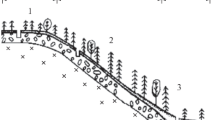Summary
The concentration of 20 elements (including eight nutritional elements) in spruce needles was monitored by taking samples at nine different dates in a single year. On each date the youngest and the 1-year-old needles were collected at four different sites. The needles were washed with an organic solvent to remove surface contamination before analysis by instrumental neutron activation. Although the sites showed widely different concentrations for the same element, they could be treated as a uniform population using normalized concentration values. Taking the time dependence of the concentration and the ratio of the concentrations in new and old needles as criteria, the following three groups of elements could be distinguished: 9 group I —Ca, Sr, Ba, and Mn; group II — Al, Br, Co, Fe, Hg, La, Sc, Sb, and Zn; group III — K, Rb, Cs, P, and Cl. Mg and Na did not fit into any of these groups. Within group I and III elements the strongest variations occur during the growing season (late spring and early summer) and the weakest during the dormant season; the variation is greater in the younger needles. Group II elements show an approximately linear increase throughout the year in both the younger and older needles. The concentrations of elements of groups I and II increase with time, while those of group III decrease. Na is unique insofar as its concentration is influenced by foliar uptake of road de-icing salt. The concentration of elements belonging to the same group shows strong inter-element correlations. The grouping of elements deduced here shows similarities with the chemical nature of the elements and with their transportability within the plant.
Similar content being viewed by others
References
Ahrens E (1964) Untersuchung über den Gehalt von Blättern und Nadeln verschiedener Baumarten an Kupfer, Zink, Bor, Molybdän und Mangan. Allg Forst-Jagdzg 135:8–16
Anonymous (1980) Wissenschaftliche Tabellen Geigy, CibaGeigy, Basel
Anonymous (1986) Forschungsbeirat der Bundesregierung und der Länder Waldschäden/Luftverunreinigungen, 2. Bericht, KfK
Atkinson D, White GC (1980) Some effects of orchard soil management on the mineral nutrition of apple trees. In: Atkinson D (ed) Mineral nutrition of fruit trees. Butterworth, London, pp 147–180
Bajo S, Wyttenbach A (1986) Instrumental neutron activation analysis of phosphorus in biological materials by bremsstrahlung measurement. EIR rep 607, Würenlingen
Bouma D (1983) Diagnosis of mineral deficiencies using plant tests. In: Läuchli A, Bieleski RL (eds) Inorganic plant nutrition. Springer, Berlin Heidelberg New York, pp 120–146
Coughtrey PJ, Thorne MC (1983) Radionuclide distribution and transport in terrestrial and aquatic ecosystems, vol 3. Balkema Rotterdam
kenk G (1985) Zur langfristigen Wirkung von Düngung. Mitt Forstl Versuchsu Forschungsanst Baden-Württemberg 114: 1–42
Krivan V, Schaldach G (1986) Untersuchungen zur Probenahme und -vorbehandlung von Baumnadeln zur Elementanalyse. Fresenius Z Anal Chem 324: 158–167
Lange OL, Gebel J, Zeller H, Schramel P (1986) Photosynthese-Kapazität und Magnesiumgehalte verschiedener Nadeljahrgänge bei der Fichte. Jül-Spez 369: 127–147
Langille AR (1978) Effect of date and method of application on radioactive sodium content of white spruce and American arborvitae. Hortic Sci 13: 294–295
Larcher W (1980) Physiological plant ecology. Springer, Berlin Heidelberg New York
Mies E, Zöttl HW (1985) Zeitliche Aenderung der Chlorophyll- und Elementgehalte in den Nadeln eines gelbchlorotischen Fichtenbestandes. Forstwiss Centralbl 104: 1–8
Prinz B, Krause GMH, Stratmann H (1982) Waldschäden in der Bundesrepublik Deutschland. LIS rep 28, Essen
Rentschier I, Schreiber H (1986) Der Einfluß der Oberflächenstruktur von Blättern und Nadeln von Waldbäumen. KfK-PEF 4: 703–718
Robson AD, Pitmann MG (1983) Interactions between nutrients in higher plants. In: Läuchli A, Bieleski RL (eds) Inorganic plant nutrition. Springer, Berlin Heidelberg New York, pp 147-l80
Schulze ED, Oren R, Werk K, Meyer J, Zimmermann R (1986) Kohlenstoff-, Wasser- und Nährstoffhaushalt von Fichten. Jül-Spez 369: 106–117
Tobler L, Bajo S, Wyttenbach A (1988) Deposition of 134, 137-Cs from the Chernobyl fallout on Norway spruce and on the forest soil, and its incorporation into spruce twigs. J Environ Radioactivity 6: 225–245
Woolhouse HW (1983) Toxicity and tolerance in the response of plants to metals. Encycl Plant Physiol 12C: 245–300
Wyttenbach A, Bajo S, Tobler L, Keller T (1985) Major and trace element concentrations in needles of Picea abies. Plant Soil 85: 313–328
Wyttenbach A, Bajo S, Tobler L (1987) Aerosols deposited on spruce needles. J Radioanal Nucl Chem 114: 137–145
Author information
Authors and Affiliations
Rights and permissions
About this article
Cite this article
Wyttenbach, A., Tobler, L. The seasonal variation of 20 elements in 1st and 2nd year needles of Norway spruce, Picea abies (L.) Karst. Trees 2, 52–64 (1988). https://doi.org/10.1007/BF00196980
Received:
Revised:
Issue Date:
DOI: https://doi.org/10.1007/BF00196980




